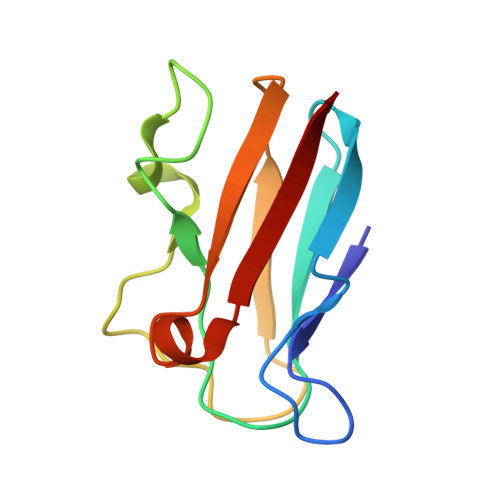Structural comparison of the poplar plastocyanin isoforms PCa and PCb sheds new light on the role of the copper site geometry in interactions with redox partners in oxygenic photosynthesis.
Kachalova, G.S., Shosheva, A.C., Bourenkov, G.P., Donchev, A.A., Dimitrov, M.I., Bartunik, H.D.(2012) J Inorg Biochem 115: 174-181
- PubMed: 22883960
- DOI: https://doi.org/10.1016/j.jinorgbio.2012.07.015
- Primary Citation of Related Structures:
4DP0, 4DP1, 4DP2, 4DP4, 4DP5, 4DP6, 4DP7, 4DP8, 4DP9, 4DPA, 4DPB, 4DPC - PubMed Abstract:
Plastocyanin (PC) from poplar leaves is present in two isoforms, PCa and PCb, which differ in sequence by amino acid replacements at locations remote from the copper center and simultaneously act in the photosynthetic electron-transport chain. We describe ultra-high resolution structures of PCa and high-resolution structures of PCb, both under oxidizing and reducing conditions at pH 4, 6 and 8. The docking on cytochrome f and photosystem I, respectively, has been modeled for both isoforms. PCa and PCb exhibit closely similar overall and active-site structures, except for a difference in the relative orientation of the acidic patches. The isoforms exhibit substantial differences in the dependence of the reduced (Cu(I)) geometry on pH. In PCa, the decrease in pH causes a gradual dissociation of His87 from Cu(I) at low pH, probably adopting a neutral tautomeric state. In PCb, the histidine remains covalently bound to Cu(I) and may adopt a doubly protonated state at low pH. The fact that both isoforms have similar although not identical functions in photosynthetic electron flows suggests that the His87 imidazole does not play a crucial role for the pathway of electron transport from cytochrome f to oxidized PC.
Organizational Affiliation:
A.N.Bach Institute of Biochemistry, Russian Academy of Sciences, Leninsky pr., Moscow 119071, Russia.


















